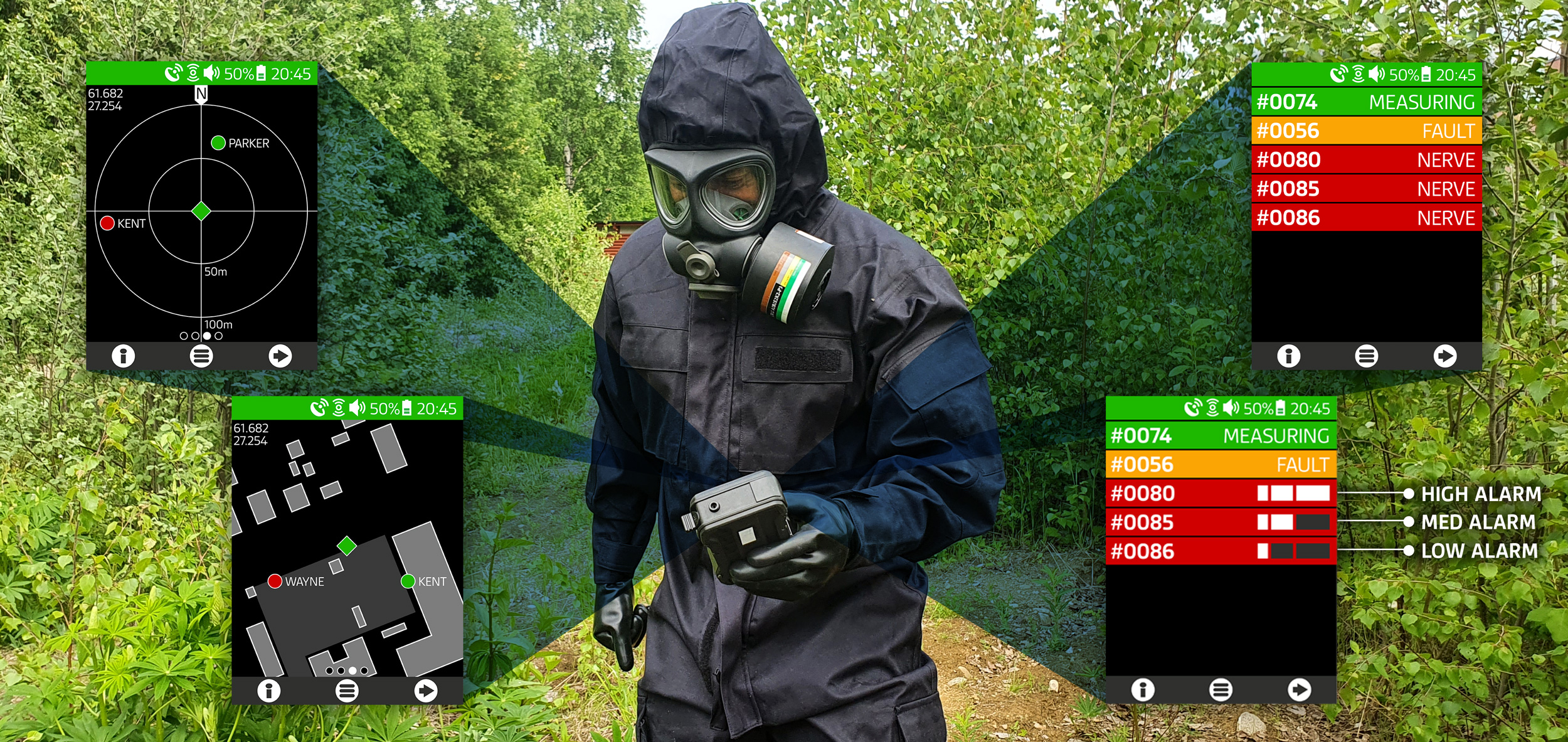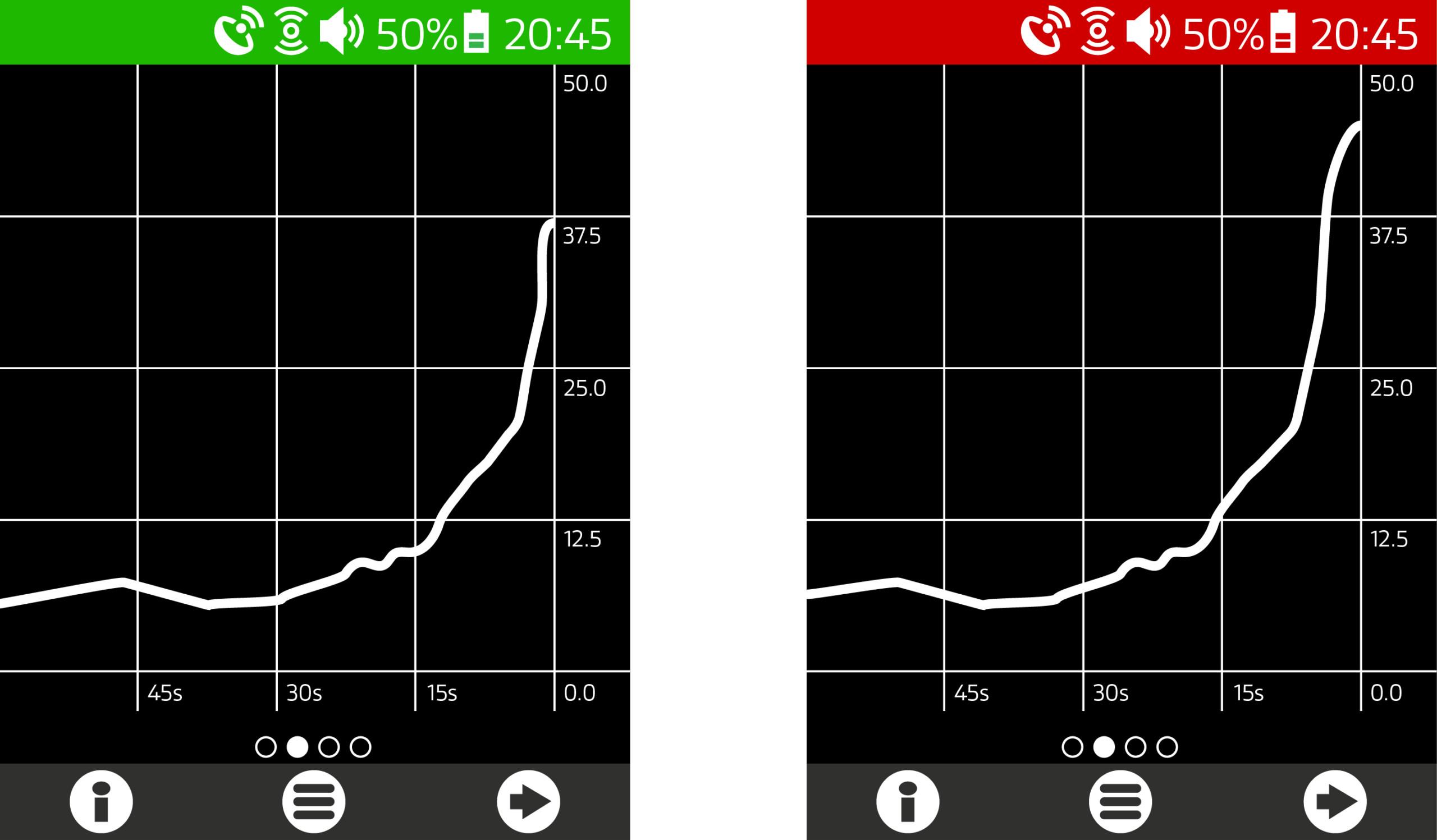Handheld Early Warning Chemical Detector
Since its launch in 2019, ChemProX became a well-known and reliable chemical vapor detector among many professionals and organizations, in both military and first responder fields.
Its built-in training mode and multiple different wireless communication features have been seen as valuable assets and enhancements, when comparing to other early warning detectors that rely on more traditional ways of delivering crucial information of the hazard situation. In addition to that, it is good to emphasize that the training aspect in detectors from older generations still relies heavily on expensive simulators and simulant chemicals.
All these new features have had a major impact on how ChemProX has been received by the end-users, and it has changed the way handheld early warning detectors can be utilized in different scenarios. However, despite all the novelties ChemProX has brought to market, its main purpose remains clear: to give early warning when in presence of harmful chemical compounds, both CWAs and TICs/TIMs, as fast as possible and in low enough concentration levels so that the operators have time to protect themselves and to provide enough information, in order to classify the threat, and correct countermeasures can be prepared. This role in measurement chain ChemProX has been proven to fill very well.

ChemProX early warning detector’s user interface showcasing a variety of situations in which the geo location and status information (including alarm level intensity) of each device involved in a group mission is shared across all operators.
Detecting Unknown Chemical Vapor Sources
But there is another application where ChemProX can be utilized, thanks to its unique aspiration IMS and orthogonal detection design. This is detecting unknown chemical vapor sources.
In many cases, the detectable threat is kind of expected, for example in a chemical plant environment, where it is already known what might be in the air in case of an emergency. But there are also cases where it isn’t clear what is causing some weird symptoms or unusual smell in a place where there shouldn’t be anything unusual: then, the threat is unknown. Before first responders can do anything to identify, remove or otherwise react, the threat must first be detected. That is a job best handled with a chemical detector that can detect the widest range of chemicals. And that detector is ChemProX and I’m going to tell you why.
Chemical Detection Based on IMS Technology & Orthogonal Sensors
As mentioned earlier, ChemProX‘s detection is based on aspiration IMS and orthogonal sensors. Aspiration, or in other words “open loop”, means that the measured air is withdrawn continuously through the measurement path, from inlet to outlet. Therefore, ChemProX measures 100% of the time it is turned on.
ChemProX ionizes the sample air O2 and N2 molecules to create the so called reactant ions, that eventually form ion clusters with target chemicals. This ionization is handled by a Ni63- source, which is radioactive but completely harmless to the user. Its activity is 90 MBq and it is exempted from regulatory control by IAEA, so it is a safe and reliable source for this purpose.
I mention the Ni63 source, because it is one of the main reasons why ChemProX is so good at detecting unknown chemical threats compared to other detectors in its class. If we compare the ionization energy of ChemProX‘s Ni63 source to another well-known universal detection technology, PID (Photo Ionization Detector) we can form a scale of its potential. The maximum ionization energy for PIDs UV- lamp is 11,7eV. This means that PIDs only respond to chemicals that have ionization energy less than, or equal, to ionization to energy of the UV- lamp. This creates the limit for chemical compounds that can be caught with PID.
The averaged ionization energy of ChemProX‘s Ni63 source is 17 keV. That is 17000 eV and over 1000 times more than PIDs strongest UV- lamp. So, in practice, this means that ChemProX has the potential to detect chemicals that cannot be ionized with PID at all.
Orthogonal Detection Technology
Ionization is only the first part of the actual detection. When sample air is ionized, ion clusters are created and measured with IMS, there might be certain species of chemical or some chemical molecules that don’t react with reactant ions and because of that are not detectable by IMS. But… do you remember the orthogonal detection design I mentioned earlier? This is where it shows its prowess.
Orthogonal detection technology means that the detection is handled with more than one sensor. On top of the aspiration IMS, ChemProX has one metal oxide sensor (MOS) and 3 semiconductor sensors. Any chemical molecules that are not detectable with IMS are not completely lost, because hese 4 orthogonal sensors have been selected to catch a wide range of chemicals, especially TICs and TIMs that are not visible with IMS. And all this happens in real time!
Designed for Field Chemical Detection
Currently, ChemProX is the only handheld chemical vapor detector on the market that is designed to work this way, since it was designed from the start for field usage and as an everyday tool for first responders, instead of being a miniaturized version of a laboratory instrument.
Chemical Threats Made Visible
All the above technical information would be just flexing if it’s not taken into practice in a user-friendly way.
And for that ChemProX has yet another unique feature: the trend line. Because of the real time measurement made possible by aspiration technology, we can show real time response of all the sensors, IMS, MOS-sensor, and semiconductors, in graphical form.
The trend line plot is placed on a graph that has time in X-axis and combined sensor response compared to background in Y-axis. Any deviation from the background will make the trend line go higher. The higher the deviation, the higher the trend line response on display. In other words, the more contamination detected, the higher the trend line.

The trend line is a graphical representation of the relative concentration of an unknown chemical. On the left, it is possible to see the concentration increasing even before reaching alarm triggering levels. On the right, the device is already alarming. The alarm is visible and audible.
Now let’s get back to those weird symptoms or unusual smell in a place where there shouldn’t be anything unusual.
You enter the place with ChemProX in your hand and see that the trend line is reacting. You start scanning around the place and the closer to the source of contamination you get, the higher the trend line will rise. Eventually, you will find the point where trend line response is the highest. In this area there will, most likely, be the source causing the symptoms or smell.
If the chemical is something that is included in one of the detection modes of ChemProX, an alarm will be triggered if the alarm threshold is exceeded. If it’s something that is not included in any of the detection modes, you will still see it as a response in the trend line.
And that is the main point of this whole blog post: if there is an unknown chemical in the air, you will — most likely — find it with ChemProX. And after you have found it, you can do something about it.
For real life experiences of how this ability of ChemProX has been utilized in the field, you can check another blog, written by Product Manager Mika Saarinen: Locating Chemical Sources with ChemProX, Such as Refrigerant Leaks.

Detecting Unknown….. Explained very Clearly in Simple Terms………Leaves No Doubt
Thanks for your feedback!
Are you going to be in Phoenix for the AIHce?
Dear Glenn, after confirming this with our US based team I can share we are not participating in AIHce. However, you may address any questions or requirements directly to Bertin Environics in USA President Michael Phillips michael.phillips(at)environicsusa.com / +1 386 383 0386 and he will be glad to help you.
How have the new features introduced in ChemProX impacted its reception among end-users and its utilization in various scenarios?
telkom university
Hi Informatika!
Since many of the new features we release in our products, as ChemProX, are usually something that has been already asked by our existing end-users the response has been very good among new end-users as well. Since ChempProX is chemical detector suitable for multiple different applications, we have asked feedback from the end-users of said applications to make its utilization more approachable and easier. We plan to continue this process and support for the whole lifetime of ChemProX.